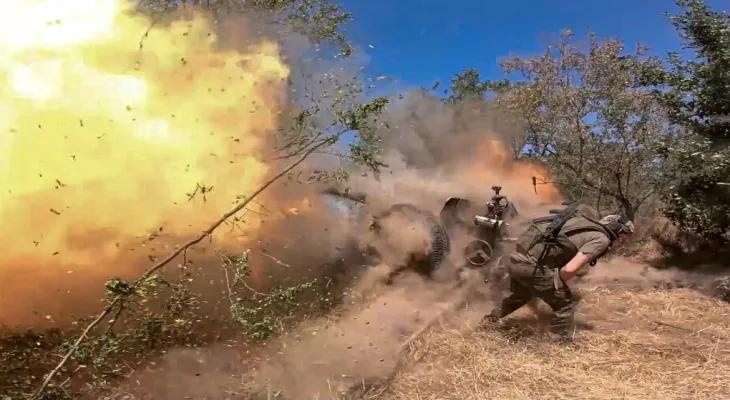Search here
Newspaper
Search here

Arab Canada News
News

Published: August 23, 2024
The Ukrainian armed forces said they used precision-guided munitions provided by the United States to carry out strikes in Russia's Kursk region, claiming to have regained some territory in the eastern Kharkiv region, where Russia launched an offensive in the spring.
Ukrainian Air Force Commander General Mykola Oleschuk released a video on Thursday evening that allegedly shows a Russian platoon base being bombarded in the Kursk region. He stated that the GBU-39 bomb attack resulted in Russian casualties and destruction of equipment.
The video displayed multiple explosions and columns of smoke rising from the site.
Separately, the third separate assault brigade in Ukraine stated that its forces advanced by nearly two square kilometers (about three-quarters of a mile) in the Kharkiv region. No details were revealed regarding the timing, scope, or area of the attack, making it difficult to predict whether it would have any further impact on the battlefield.
The Ukrainian forces gained renewed momentum this month after finally receiving delayed U.S. weapon shipments. Kyiv launched a surprise attack on western Kursk region in Russia on August 6, while simultaneously intensifying its drone war against military and fuel targets that ignited deep fires in Russia this week.
New details emerged on Friday regarding the damage and casualties resulting from some of those attacks.
Satellite images captured on Friday revealed that an attack by a Ukrainian drone on a remote Russian airbase in the Volgograd region caused severe damage to an airport reportedly housing precision-guided munitions used by Moscow in the war.
Meanwhile, the official Russian news agency TASS reported on Friday that an attack on a cargo ferry in the Kavkaz port of Russia's Krasnodar region on Thursday resulted in 13 injuries. TASS quoted health officials as saying that four of the injured were hospitalized and one person remained missing.
Ukraine's gains have reshaped the battlefield and boosted the morale of Ukrainians after 10 years since Russia first invaded their country, and after two and a half years since Moscow launched a wide-ranging invasion that led to mass death and destruction, creating the largest refugee crisis in Europe since World War II.
Ukraine and its Western allies hope that the regained momentum will bolster Kyiv's position on the diplomatic front.
The visit of Indian Prime Minister Narendra Modi to Kyiv, where he will meet President Volodymyr Zelensky on Friday, is being closely followed. Modi, who has maintained friendly relations and economic ties with Russian President Vladimir Putin, may play a role in facilitating peace negotiations.
The incursion into Russia highlighted Russian vulnerabilities but also increased pressure on Ukrainian forces, which were already fighting on a frontline that stretches hundreds of kilometers. This may have undermined Ukraine's ability to repel Russian forces that have slowly but steadily gained ground in the Donetsk region, diverting Ukrainian troops that could have reinforced defenses there.
It remains unclear how long Ukraine will be able to hold onto the territory it has seized in Russia.
The Russian Ministry of Defense stated on Friday that its forces repelled Ukrainian attempts to advance toward the villages of Burkiv and Malaya Luhynia in the Kursk region. The ministry also reported that it destroyed a reconnaissance and sabotage group near Kamyshevka, 20 kilometers (12 miles) north of Sudzha, which was controlled by the Ukrainians.
The third separate assault brigade of Ukraine stated in a statement released late Thursday that Ukrainian soldiers also took control of an area that was under the control of a Russian battalion and some strongholds.
Brigade commander Andriy Biletsky said they attacked Russian forces that were outnumbered "and won," adding that the troop ratio on the battlefield was 2.5:1 in favor of Moscow.
The Associated Press was unable to independently verify these claims, and there was no immediate comment from Russia.
Russia launched an offensive in the Kharkiv region in May, resulting in some gains, but it soon stalled. Fighting in that area diminished as the Russian army focused its efforts in Donetsk, which is part of the industrial Donbas region that it has formally annexed but does not fully control.
The Russian advance in the spring toward Kharkiv is seen as a sign of Ukraine's weakened position amid delays in Western military aid.
Comments